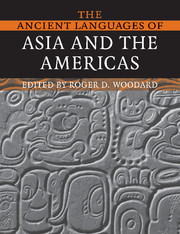Book contents
- Frontmatter
- Contents
- List of figures
- List of tables
- List of maps
- List of contributors
- Notes on numbering and cross-referencing
- List of abbreviations
- Preface
- Preface to the first edition
- 1 Language in ancient Asia and the Americas: an introduction
- 2 Sanskrit
- 3 Middle Indic
- 4 Old Tamil
- 5 Old Persian
- 6 Avestan
- 7 Pahlavi
- 8 Ancient Chinese
- 9 Mayan
- 10 Epi-Olmec
- Appendix 1 Reconstructed ancient languages
- Appendix 2 Full tables of contents from The Cambridge Encyclopedia of the World's Ancient Languages, and from the other volumes in the paperback series
- Index of general subjects
- Index of grammar and linguistics
- Index of languages
- Index of named linguistic laws and principles
1 - Language in ancient Asia and the Americas: an introduction
Published online by Cambridge University Press: 01 September 2010
- Frontmatter
- Contents
- List of figures
- List of tables
- List of maps
- List of contributors
- Notes on numbering and cross-referencing
- List of abbreviations
- Preface
- Preface to the first edition
- 1 Language in ancient Asia and the Americas: an introduction
- 2 Sanskrit
- 3 Middle Indic
- 4 Old Tamil
- 5 Old Persian
- 6 Avestan
- 7 Pahlavi
- 8 Ancient Chinese
- 9 Mayan
- 10 Epi-Olmec
- Appendix 1 Reconstructed ancient languages
- Appendix 2 Full tables of contents from The Cambridge Encyclopedia of the World's Ancient Languages, and from the other volumes in the paperback series
- Index of general subjects
- Index of grammar and linguistics
- Index of languages
- Index of named linguistic laws and principles
Summary
1 O Bṛhaspati. When in giving names they first set forth the beginning of Language,
Their most excellent and spotless secret was laid bare through love.
2 When the wise ones formed Language with their mind, purifying it like grain with a winnowing fan,
Then friends knew friendships – an auspicious mark placed on their language.
3 Through sacrifice they tracked the path of Language, and within the poets found it.
Bearing it, they spread it abroad – in many places; the seven singers together spoke it loud.
4 One looking did not see Language; another listening did not hear it;
Language unfolds itself to another – like a wife, beautifully adorned and willing, to her husband.
Rig-veda 10.71.1–4The present volume covers far greater geographic space than any of its companion volumes: all of Asia is included – excepting the linguistically rich regions of Asia Minor, with Transcaucasia (see The Ancient Languages of Asia Minor) and southwest Asia (which readers will find covered within the volumes entitled The Ancient Languages of Mesopotamia, Egypt, and Aksum and The Ancient Languages of Syria-Palestine and Arabia) – as well as the American continents (or continent, as one prefers). Over half of the languages examined in the chapters that follow were spoken in ancient Iran, central Asia, and the Indian subcontinent; and of these, all were Indo-European languages, with the exception of the Dravidian language of Old Tamil.
- Type
- Chapter
- Information
- The Ancient Languages of Asia and the Americas , pp. 1 - 5Publisher: Cambridge University PressPrint publication year: 2008



